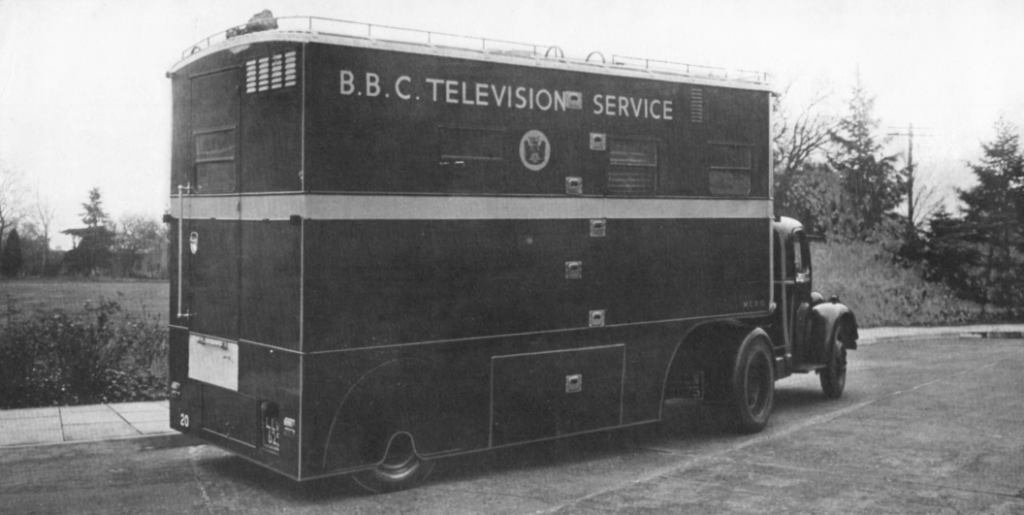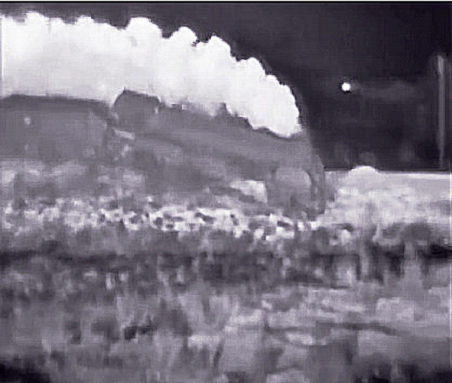Alex Thomas
I recall the overnight movement of a colour scanner (or was it the MCCR?) from a golf tournament in Scotland to another golf tournament in Wentworth.
A driver was supplied by an agency and roared off into the night. When the little red light on the dashboard lit up, he ignored it and the engine was wrecked.
The vehicle arrived at Wentworth behind the biggest breakdown truck that I had ever seen. I wonder who paid the bill.
Bernard Newnham
One of the OBs I was on in my six months attachment was at Hickstead. The scanner wouldn’t start afterwards and had to be towed to the next booking. Naively I said “Why aren’t they articulated?” . Not so naive as it turned out, because no-one seemed to know – “That’s the way we do it”. I never did find our why.
Alec Bray
Many many moons ago, when I was a schoolboy back in the 1950s, I used to go round to my grandmother’s house to watch TV – my granddad was one of the first in his street to get a TV (mainly because he had a longish history of interest in Radio, I think) – and, of course, to start with it was a 9 inch set.
Anyway, on Saturday mornings (again, I think, as far as I remember etc) there was a regular film – I guess we would now call it a promo – of an OB unit setting off for a mission – may it have been to do an OB from over the channel? One of the vehicles was definitely articulated, with a Bedford tractor. Dunno if it was the scanner or just an equipment trailer.
Robin Sutherland
[I have found] the opening sequence of the OB show “ Saturday Night Out”. It’s on a compilation tape made in 1997 to commemorate 60 years of BBC OBs and issued as a gift to all OB staff as a VHS. Still got mine somewhere.
Brian Curtis
It occurred to me that this video should be compulsory viewing for all our aspiring “media students” to show them the birth of their “noble profession” – huge cameras, difficult TX links and “derring do” – so that they can understand what it was like before Go-Pro’s, IP world links and “up to the neck H&S”
Alec Bray
It may well have been the same bit of film, but what I remember is this: there was a definite commentary to the film, explaining about “Outside Broadcasts”, and I don’t remember those vehicles setting out at high speed – more of a sedate “chug” if I remember correctly – but that is, of course, the point! It were all a long time ago …
[However], this is EXACTLY what I remember, near the beginning of the programme:- at 0:36!! A very sedate exit from the Palace of Arts!


John Cox
You [may have been] watching the opening titles of “Saturday Night Out” which were filmed yes filmed at the Palace Of Arts OB base at Wembley, opposite the old Empire Pool. If you can refer to the picture of P O A in which I identified many people, I will explain. Just behind the management people on the left was a small room as the Private Branch Exchange (PBX), one of the operators was Alan Wolford’s mother who could recognize everyone by their voice and would speak to them by their Christian name. In the opening titles the voice you hear saying “Outside Broadcast, we’re starting now” is that of Derek Burrell-Davis the producer, then there is a cut to the vehicles leaving from inside. The first one is the one and only Roving Eye followed by the Articulated heavy goods trailer and then followed by the camera van which carried the cameras and sound equipment. Of course other scanners would be at the location. There weren’t any articulated scanners at Wembley when I was there in the 1950s. I was on Radio Links with Bert Robinson on February 11th 1956 on the coldest night of the year when the famous train crash was staged at the Army Depot at Longmoor in Hampshire. There had been a big build up by Robert Beatty before the event but the actual crash was underwhelming. I can’t remember what the talkback was like but the long delay from Robert said everything! See www.turnipnet.com.

See also:Steam Powered Tech Ops
Derek Burrell-Davis was the producer for many “Billy Smart’s Circus” programmes. On one occasion we did a circus show from the circular car park in front of Television Centre with big animals. We laid 4035 microphones around the centre track but unfortunately during rehearsal an elephant trod on one and crushed it. I can still hear the producer shouting “stop the elephants” walking in the “live “ take. Derek Burrell-Davis married his production secretary Mary who became a producer in her own right.
Tony Grant
Regarding the Saturday ‘trail’ of OB vehicles. there was a programme on Saturday night (when there was only BBC TV, no channel two) which had its title sequence (filmed) of an OB unit setting off from base (Palace of Arts?) and was called something along the lines of ‘Saturday Night Out’.
Anyhow, the programme itself was ostensibly live from whatever location they’d picked. I particularly remember one Saturday evening they’d picked the Snowdon railway, and during the whole evening the mountain was shrouded in mist, and so you couldn’t see a thing (apart from close shots of the carriage/s. I was enormously disappointed (oops, I’ve started another railway topic, it’s rack and pinion, narrow gauge, head in the clouds).
Simon Vaughan
“…I was sad to hear that an old friend of many years, Ralph Parrott, has passed away at the age of 95. He was a typical BBC engineer, always ready to work.
I first met Ralph in 1948 when I joined Tel O.B.s after the 1948 Olympics at Wembley. He always had good ideas, one of which was the ‘parrer-peep’ – a periscope with two large mirrors on the front of a dolly that enabled us to see the feet of the dancers.
He was an excellent teacher and great fun to work with, but he never wanted to become ‘In Charge’ of a unit. Rather, he always suggested an easier way of achieving an excellent output to a programme. During his last years with the BBC, he assisted in the layout of the Outside Broadcasting complex at Wimbledon, and his last OB was at the 1977 tennis finals… “ [Prospero, February 2011].
As well as “Saturday Night Out”, there was” Now” – a similar style of programme. At 16:38 in the video you see the opening sequence for “Now”. The edition featured was tx 12th June 1957.
Ralph Parrott, developed the caption apparatus for the opening sequence of this programme. It was called the “Parroscope” and still has the metal printed label attached to the side. We also hold a copy of the operating instructions.
In the early 1990s Ralph donated his collection of early OB caption apparatus to the APTS Archive.
Ron Chown:
Peter Cook
One reason (or myth) about articulated scanners was that in many cities and towns it was not possible to remove the donkey in case of a need to move in emergency. This would obviously waste the parking space available, so rigid trucks prevailed.
There may of course be other equally valid theories on the subject.



